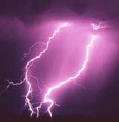Where Lightning Strikes
Congo under fire
 New maps from orbiting sensors can detect flashes of lightning even during the daytime revealing where on Earth the powerful bolts will most likely strike. Earth's lightning hot spots are the Himalayas and
central Africa - but lightning almost never strikes the
north or
south poles.
New maps from orbiting sensors can detect flashes of lightning even during the daytime revealing where on Earth the powerful bolts will most likely strike. Earth's lightning hot spots are the Himalayas and
central Africa - but lightning almost never strikes the
north or
south poles.
The development of space-based optical detectors is giving lightning researchers their first complete picture of planet-wide lightning activity. For the first time the lightning team at NASA's National Space Science and Technology Center (NSSTC) has been able to map the global distribution of lightning and its variation as a function of latitude, longitude and time of the year.
 The new perspective on lightning reveals that lightnings are most frequent over land-masses where the atmosphere is hot and damp and even more so over mountain areas where the extreme topography forces air masses to rise. Lightning avoids the ocean, because of the temperature-regulating effect of the water body and also arctic regions where polar air is to dry and cold for thunderstorms to develop. The Congo basin is hit by 50 strikes per square kilometer and year.
The new perspective on lightning reveals that lightnings are most frequent over land-masses where the atmosphere is hot and damp and even more so over mountain areas where the extreme topography forces air masses to rise. Lightning avoids the ocean, because of the temperature-regulating effect of the water body and also arctic regions where polar air is to dry and cold for thunderstorms to develop. The Congo basin is hit by 50 strikes per square kilometer and year.
Ground-based lightning detectors provide high-quality local measurements, but they have a limited range. However, most thunderstorms remain unnoticed by humans and the vast majority of lightnings discharges from cloud to cloud. Only one out of four strikes the ground.
Related links:
Check out the Lightning map